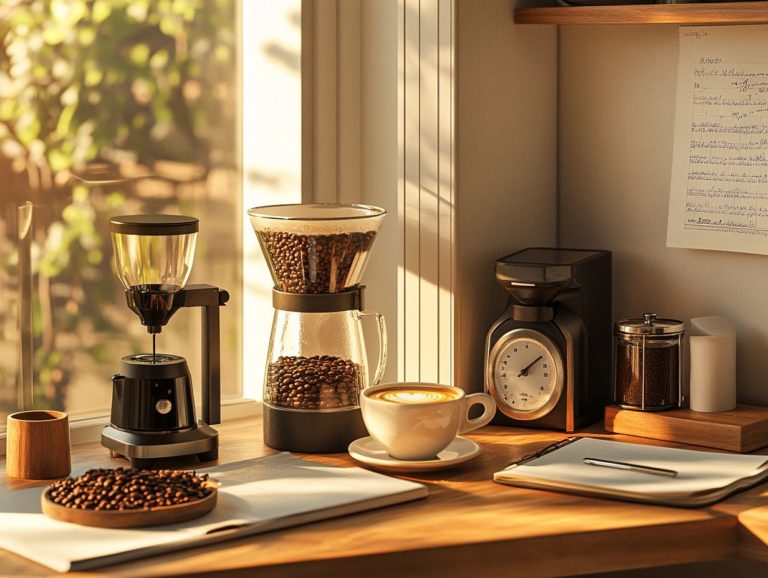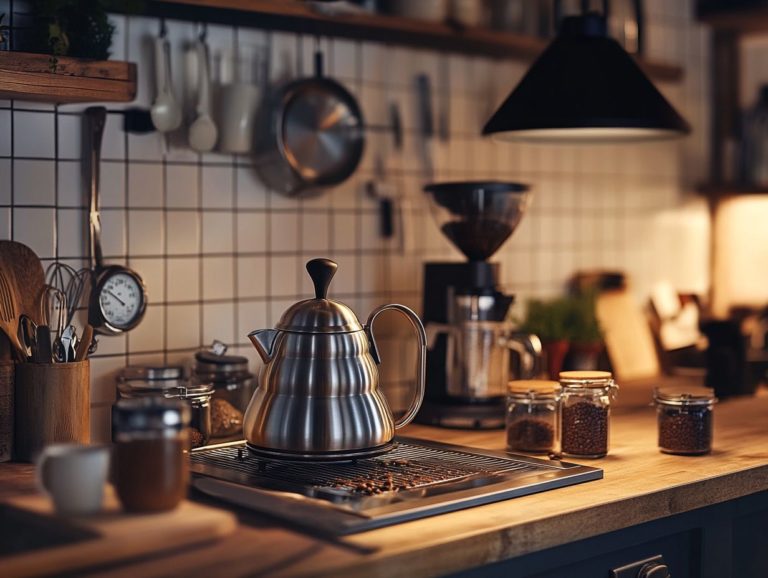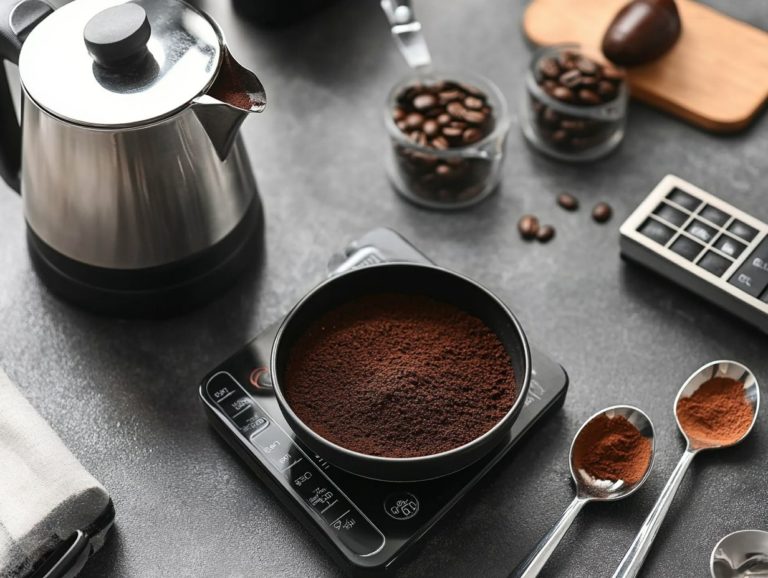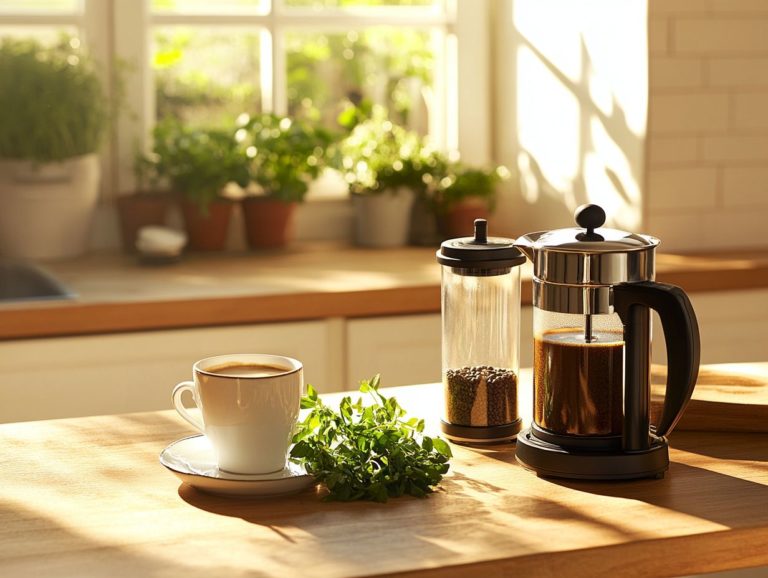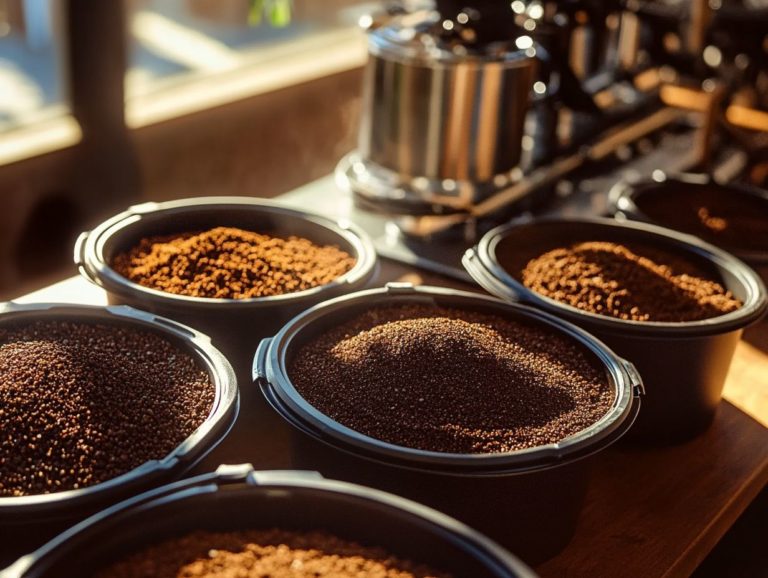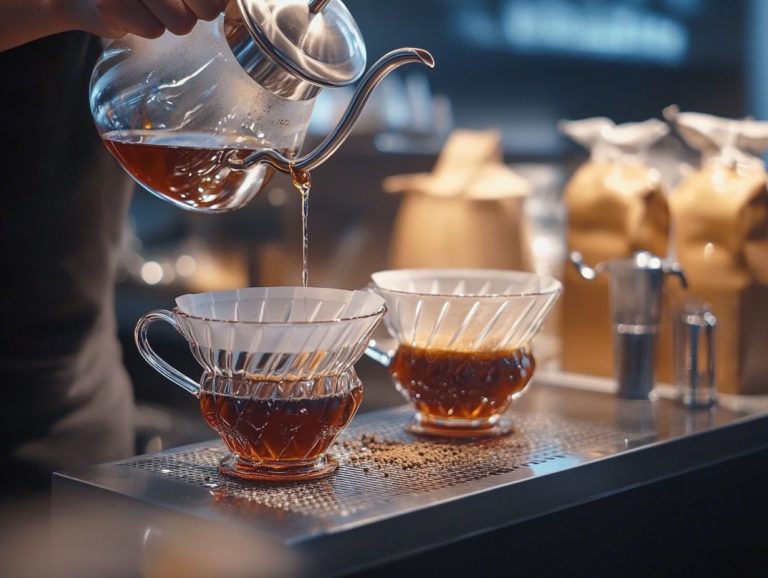How to Brew Coffee with a Percolator
Contents
- Elevate Your Coffee Brewing Experience with a Percolator
- Key Takeaways:
- What Is a Coffee Percolator?
- How Does a Percolator Work?
- What Are the Different Types of Percolators?
- 1. Stovetop Percolators
- 2. Electric Percolators
- What Type of Coffee is Best for Percolators?
- How to Brew Coffee with a Percolator?
- 1. Preparing the Percolator
- 2. Measuring and Grinding the Coffee
- 3. Adding Water and Coffee to the Percolator
- What Are Some Tips for Brewing the Best Coffee with a Percolator?
- What Are the Pros and Cons of Using a Percolator?
- Frequently Asked Questions
- What is a coffee percolator and why is it used to brew coffee?
- What type of coffee should I use when brewing with a percolator coffee pot?
- How do I prepare my percolator for brewing coffee?
- What is the proper percolation time for a percolator?
- Can I add other ingredients to my coffee while using the percolator brewing method?
- How do I clean and maintain my coffee percolator for future use?
Elevate Your Coffee Brewing Experience with a Percolator
If you seek a distinctive approach to elevate your coffee brewing experience, a percolator could be the ideal solution. This method delivers rich flavor and infuses nostalgia into your morning routine.
Discover what a coffee percolator is and how it functions. Comprehensive, step-by-step instructions for brewing the perfect cup are included.
Whether you are a seasoned coffee lover or just starting your journey, valuable insights await every enthusiast. From brewing methods to mastering percolation time, there’s something for everyone.
Key Takeaways:
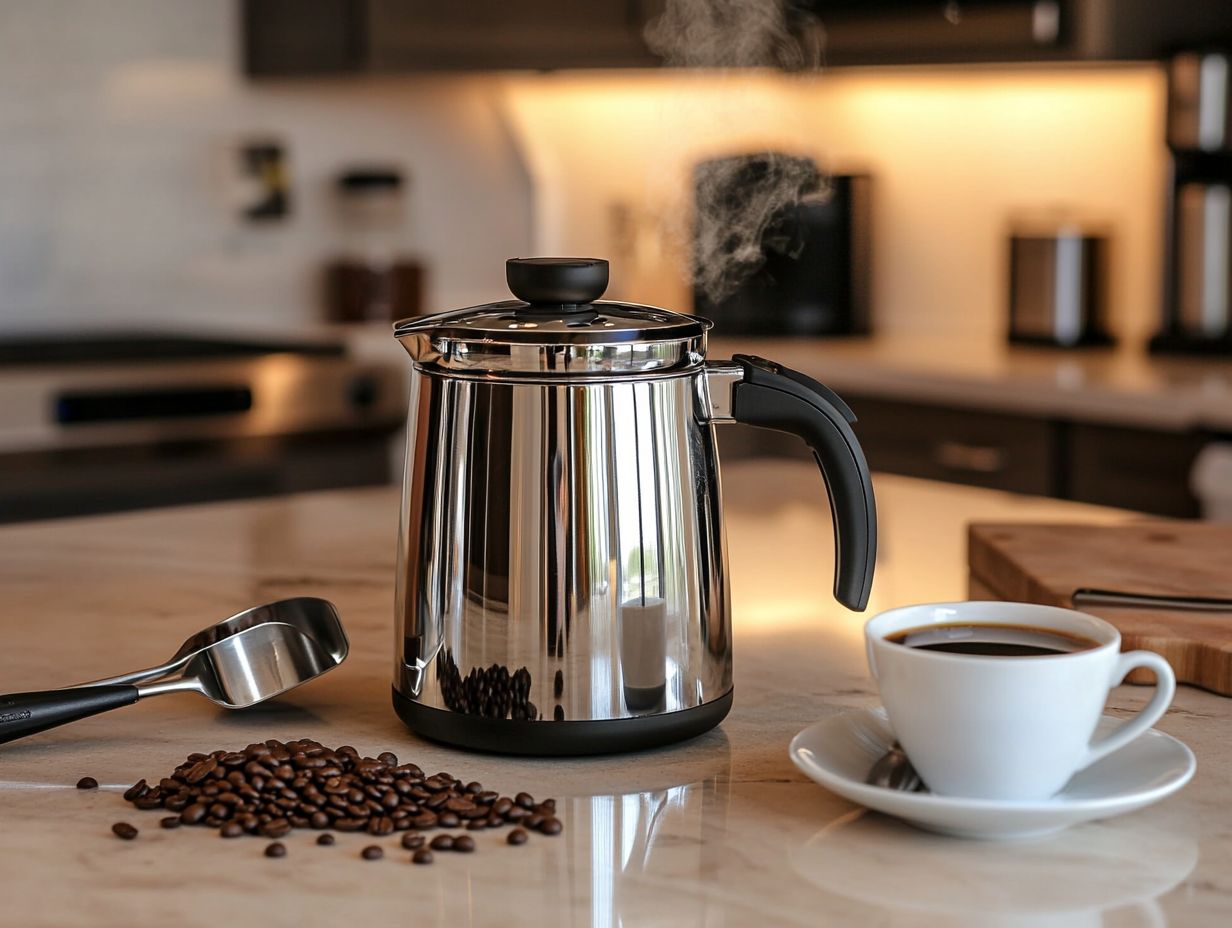
- Use freshly ground coffee for the best flavor in a percolator. Fresh coffee and high-quality coffee beans are essential to achieving that bold flavor.
- Experiment with coffee to water ratios and brewing time to find your perfect cup of coffee. Adjusting the water ratio and percolation time can significantly impact the coffee flavor and strength.
- Regularly clean and maintain your percolator for optimal brewing results.
What Is a Coffee Percolator?
A coffee percolator is a classic brewing device that employs the percolation method to extract the rich, robust flavors from your coffee grounds. This method involves cycling boiling water through the grounds, which results in a bold and flavorful cup that invigorates the senses.
Percolators come in various styles, including both stovetop and electric models. Choose a stovetop coffee percolator for a traditional feel or an electric one for convenience. With precise coffee measurements and careful attention to the brewing process, a well-crafted percolator can produce a strong cup of coffee that truly captivates.
How Does a Percolator Work?
The exquisite functioning of a coffee percolator relies on a straightforward yet remarkably effective brewing technique known as percolation. This process entails the continuous cycling of water through coffee grounds, utilizing a specific water ratio for optimal flavor extraction.
When you apply heat to the base of the percolator, the water heats up until it reaches a boiling point and rises into the filter basket, where the coffee grounds await. As the water cools and gracefully descends back into the bottom chamber, it transports the essential oils and flavors from the coffee grounds, enriching the coffee aroma and crafting a distinctly vibrant flavor profile in your cup.
What Are the Different Types of Percolators?
When considering coffee percolators, you’ll find two primary types that cater to your distinct preferences: stovetop percolators and electric percolators.
Stovetop models, such as the iconic Bialetti Moka Express and the reliable Farberware, deliver a traditional coffee-making experience. These models are often employed over a campfire or your trusty stovetop. On the flip side, electric percolators like Presto and Bozeman’s 9-cup option offer a level of convenience and consistency that appeals to those who appreciate ease of use and swift brewing times.
Each type boasts its own unique features and advantages, giving you the power to select the coffee-making technique that best suits your lifestyle.
1. Stovetop Percolators
Stovetop percolators offer a timeless approach to brewing coffee. They are renowned for their ability to deliver a robust and flavorful cup through traditional methods. These elegant devices can be utilized on various heat sources, from your home stove to portable options like JetBoil.
Comprising several parts, including the percolator base and filter basket, the brewing process involves simmering water that circulates through the coffee grounds. This allows for a rich extraction of flavors. This stovetop method holds a special place in coffee history.
Enjoy the remarkable advantages this method offers, particularly in the control it affords over brewing time. You can adjust the time to achieve your desired coffee strength. Additionally, you can easily experiment with various grind sizes and coffee-to-water ratios, crafting a personalized brew that suits your palate. Stovetop brewing is ideal for those who enjoy hands-on coffee preparation.
To elevate your stovetop brewing experience, start with fresh, high-quality coffee beans and be attentive to the heat. This will help you avoid over-extraction, which can lead to unwanted bitterness. Opt for medium roast or dark roast coffee beans for the best results.
Keeping a watchful eye on the perking process is crucial. Halting it before reaching the boiling point can help preserve the coffee’s aromatic qualities, resulting in a smoother, richer taste in every cup. This approach helps prevent the development of a bitter flavor.
2. Electric Percolators
Electric percolators have become your go-to for their unparalleled convenience and ability to brew coffee with minimal effort. Unlike their stovetop counterparts, electric percolators maintain consistent heat and brewing times. This ensures you achieve that perfect coffee strength and flavor profile every time.
Many of these devices come packed with features that allow you to monitor the brewing progress. This guarantees that the coffee grounds are extracted just right for an exceptional cup.
Beyond their ease of use, these appliances can whip up larger quantities. This makes them a fantastic choice for gatherings or those hectic mornings. Modern electric percolators often boast programmable settings, enabling you to set your brew time in advance. Imagine waking up to the rich aroma of coffee brewed just for you!
Some models even come with automatic shut-off functions, promoting safety while conserving energy. Many offer adjustable strength settings to cater to your unique taste preferences. Whether you prefer a mild or a strong coffee, you can customize your brew. This delightful combination of functionality and versatility undoubtedly elevates your coffee brewing experience, transforming each cup into a true pleasure.
What Type of Coffee is Best for Percolators?
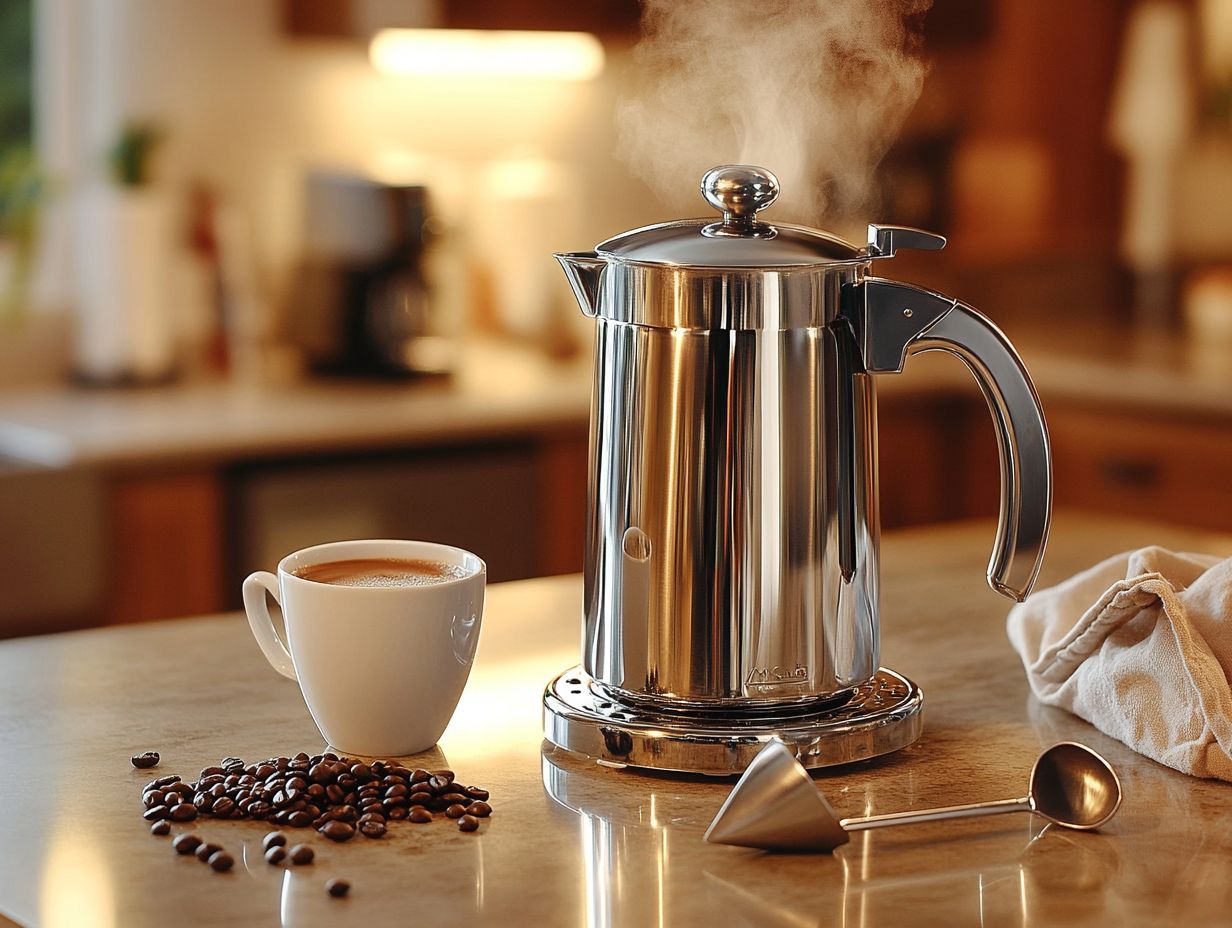
Selecting the right coffee for your percolator is essential, as it profoundly influences the final flavor and aroma of your brew. Opt for medium roast or dark roast coffee beans, which shine in a percolation process thanks to their bold flavors and robust profiles, delivering a potent coffee experience.
Make sure your coffee grounds are coarsely ground; this will help you avoid the pitfalls of over-extraction and bitterness during brewing. It results in a perfectly balanced cup every time. Coarse consistency in your coffee grounds is key for optimal percolation.
How to Brew Coffee with a Percolator?
Brewing coffee with a percolator is an art that unfolds through a sequence of carefully orchestrated steps. Each step contributes to a delightful and flavorful cup. From preparing the percolator to precisely measuring the right amount of coffee grounds and water, every detail plays a pivotal role in the final result.
By grasping the intricacies of percolation and applying meticulous brewing tips, you can truly master this classic coffee-making technique. Savor a rich, aromatic brew that elevates your coffee experience. Utilize various coffee brewing methods to discover what suits you best.
1. Preparing the Percolator
Preparing your percolator is the essential first step in crafting the perfect cup of coffee. Begin by ensuring that your percolator is clean and free from any leftover coffee residue, as this can significantly impact the flavor of your brew.
Assemble the percolator parts, including the coffee grounds basket, and ensure it is securely fitted to facilitate optimal brewing. Proper assembly is crucial for achieving the best results.
Cleaning each component thoroughly elevates your coffee’s taste and extends your percolator’s life. Regularly inspect the pot, tubes, and filter basket for any signs of wear and tear; even the smallest issue can dramatically affect your brewing results.
A clean percolator ensures a consistent and delightful coffee experience. Rinse your percolator with hot water after each use. For those stubborn remnants, consider a deeper clean using vinegar or baking soda.
Don’t forget to check the manufacturer’s instructions, as they may provide unique tips or maintenance advice that could enhance your brewing experience even further. Proper cleaning is an essential part of coffee preparation.
2. Measuring and Grinding the Coffee
Measuring and grinding your coffee is a critical step that significantly impacts both the strength and flavor of your brew. For the best results, opt for freshly ground coffee with a coarse consistency; this allows for optimal water flow during the brewing process.
It s essential to pay attention to your coffee measurements, as the right coffee-to-water ratio is the secret to achieving your ideal brewing strength. A good starting point is a 1:15 ratio for a perfectly balanced cup, meaning for every gram of coffee, use 15 grams of water.
Preferences vary some might crave a bolder flavor with a 1:12 ratio, while others prefer a milder taste with a 1:18 ratio. Experimentation is key! Different brewing methods like French press, pour-over, or espresso each require specific grind sizes and ratios to bring out their unique flavor profiles.
Remember, consistently measuring your beans and water leads to more predictable and enjoyable results, making each cup a delight.
3. Adding Water and Coffee to the Percolator
Adding just the right amount of water and coffee to your percolator is essential for crafting the perfect brew. Begin by pouring the measured water into the percolator base, ensuring that the water ratio is in harmony with the coffee grounds you’ve prepared.
Next, fill the coffee grounds basket with your freshly ground coffee, taking care to distribute it evenly for a consistent brewing experience. Finding the right balance is essential. Too much water leads to diluted flavor, while too little results in a bitter cup.
As a general rule, aim for one to two tablespoons of coffee grounds per six ounces of water, but feel free to adjust based on your personal taste preferences. To elevate your brewing game, consider using a digital scale for precise measurements.
Play around with different grind sizes coarser grinds are ideal for longer brews, while finer grinds can enhance extraction during quicker processes. Ultimately, achieving the right balance between water and coffee will enrich the taste and aroma of your brew, resulting in a satisfying cup that you’ll want to savor every single day.
4. Placing the Percolator on the Stove
Once you’ve added water and coffee to the percolator, it’s your moment to place it on the heat source of your choice. If you’re using a stovetop percolator, set it over medium heat and let the brewing process commence with a gentle simmer. Keep a close eye on the percolation time, as this will significantly influence the strength and flavor of your coffee.
Proper heat control is essential. Too high a temperature can lead to over-brewing, resulting in a bitter brew. On the flip side, insufficient heat might leave you with a lackluster cup that fails to impress. Adjusting the heat during brewing is straightforward just turn the burner down if you notice excessive bubbling. The goal is to maintain a steady, calm boil.
Watch the clock and aim for a percolation time of around 6 to 8 minutes for the ultimate taste experience. By mastering these adjustments, you can elevate your stovetop brewing technique, ensuring a delightful cup every time.
5. Monitoring the Percolation Process
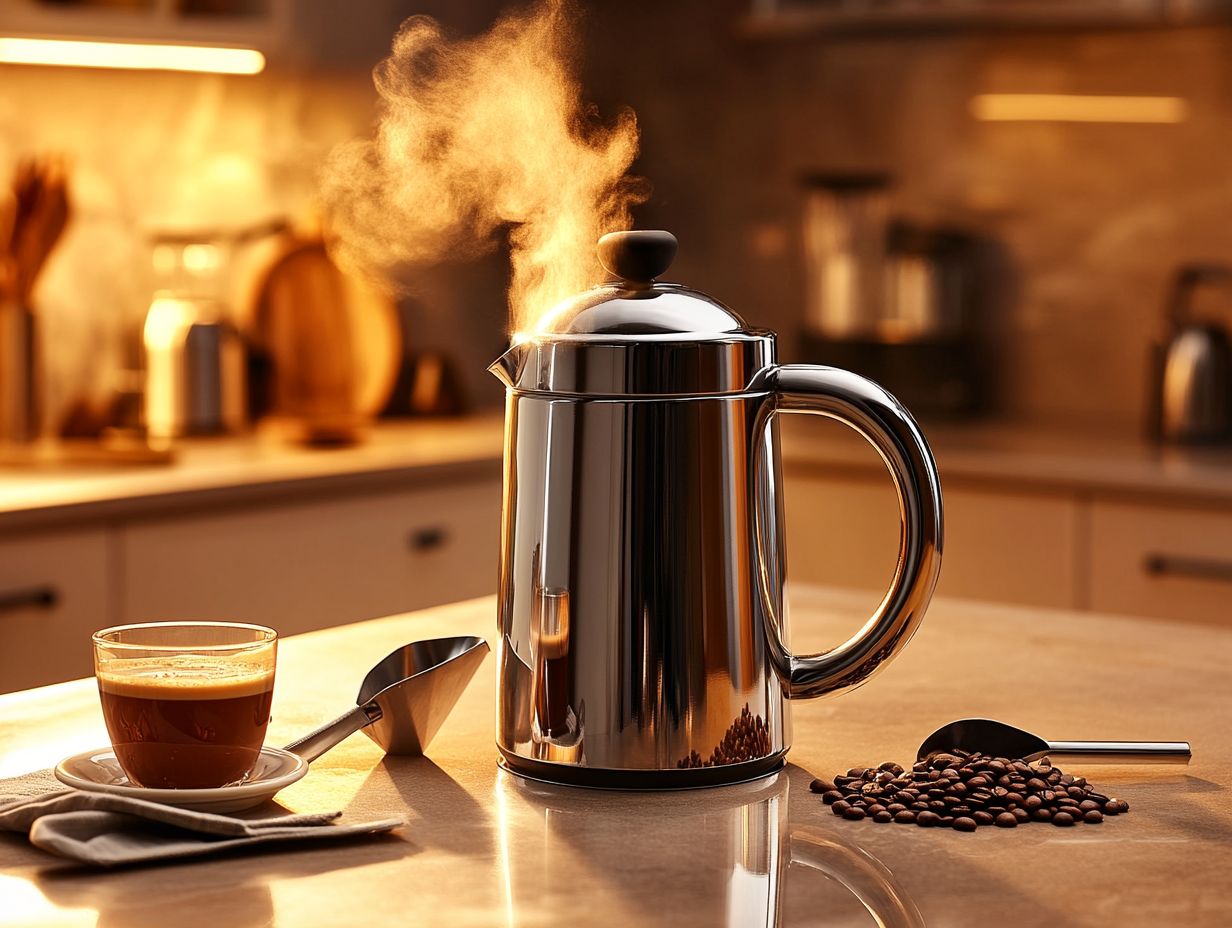
Monitoring the percolation process is essential for achieving that perfect brew. Keep a watchful eye on the brewing control and percolation time, ensuring that your coffee doesn’t brew too long, which could lead to a bitter taste. As your coffee brews, the rich aroma will envelop the air a telltale sign that your brew is nearing its delightful conclusion.
Recognizing the indicators that signal when to halt the brewing process is crucial. Don t just rely on that enticing aroma; pay attention to the color of the liquid, too. A golden-brown hue typically signifies optimal extraction. Your personal preferences will significantly influence this choice. If you favor a lighter coffee, cutting back on the brewing time can enhance those bright notes, while a preference for darker, robust flavors might call for a slightly longer brew.
Experimentation is key in this journey. Fine-tuning these elements can lead you to discover your unique cup of perfection.
6. Removing and Serving the Coffee
Now that you’ve brewed your perfect cup of coffee, it’s time to take the percolator off the heat and enjoy it! Carefully pour it into your favorite mug, being mindful to avoid any bitter notes that might have crept in from over-brewing.
Think about sharing your percolator experience with friends or diving into coffee recipes to add your personal touch to the brew. For a smoother cup, choose coarsely ground coffee beans; finer grounds can lead to a harsher flavor profile. Serving the coffee right after brewing will help preserve its optimal taste.
If you want to elevate your coffee experience, consider pairing it with a rich chocolate croissant or a slice of coffee cake these pairings create a delightful flavor harmony.
For those who appreciate a twist, experimenting with a splash of flavored syrups or a sprinkle of cinnamon can enhance your percolated coffee without inviting bitterness. Sharing your discoveries with fellow coffee aficionados can foster a wonderful community around this brewing method.
What Are Some Tips for Brewing the Best Coffee with a Percolator?
Brewing the finest coffee with a percolator demands a blend of technique, high-quality ingredients, and careful attention to detail.
By embracing expert brewing tips and familiarizing yourself with diverse coffee brewing methods, you can elevate your coffee-making prowess to new heights. Whether you lean towards a robust cup or a gentler brew, adopting specific practices will profoundly enhance the strength and overall flavor of your coffee.
1. Use Freshly Ground Coffee
Using freshly ground coffee is essential for achieving a vibrant and full-bodied flavor in your percolated coffee. As a coffee enthusiast, you understand that the freshness of your coffee grounds plays a crucial role in the brewing process, directly influencing the final taste and aroma. Aim for a coarse grind to ensure optimal extraction without any bitterness.
The rich aroma that wafts from freshly ground beans creates an inviting atmosphere. This transforms a simple cup into an extraordinary experience. When you grind coffee just before brewing, you capture the essential oils and volatile compounds that contribute to its unique flavor profile.
To enhance your coffee experience, try a burr grinder to unlock the full potential of your coffee beans! A burr grinder provides a consistent grind size that facilitates even extraction. Store your coffee beans in an airtight container, away from light and heat, to maintain their freshness for longer.
By embracing these practices, you can elevate your daily coffee ritual, savoring each sip to the fullest.
2. Experiment with Different Coffee to Water Ratios
Experimenting with different coffee-to-water ratios is essential in your quest for the perfect cup brewed in a percolator. By adjusting the water ratio, you can significantly influence the strength and boldness of your coffee, tailoring each brew to align with your unique taste preferences. It s wise to start with a standard measurement and then tweak it to achieve your desired strength.
A common starting point is using one to two tablespoons of coffee grounds per six ounces of water, but don t hesitate to adjust this according to your palate. If you lean toward a stronger, more robust cup, consider increasing the coffee quantity, while those who enjoy a lighter brew might prefer to dial it back. This simple adjustment can transform your entire coffee experience, making each sip distinctively satisfying.
Discuss water temperature and grind size to elevate your brewing process even further. Experimenting with various ratios not only allows you to customize your brew but also deepens your appreciation for the rich tapestry of flavors that coffee has to offer.
3. Adjust the Brewing Time to Your Preference
Adjusting the brewing time is essential for achieving your perfect coffee strength and flavor profile. With percolators at your disposal, you have the flexibility to experiment with different durations, allowing you to discover that ideal balance. Shorter brewing times may yield a milder flavor, while extending the brew can enhance the richness of your coffee.
Exploring these variations can significantly elevate your overall coffee experience, catering to your unique preferences, whether you lean toward bold or light tastes. It’s vital for anyone brewing their own coffee to consider the desired flavor characteristics acidity, sweetness, and bitterness all of which are influenced by the brew time.
Don t miss the chance to discover your ideal brew strength by adjusting the brewing time! Engaging in this trial-and-error process not only helps you solidify your personal taste but can also lead to delightful discoveries about what truly satisfies your palate. Experiment with different grind sizes, as they can complement your adjustments in brewing time, further refining your beverage to your specific preferences.
4. Clean and Maintain Your Percolator Regularly
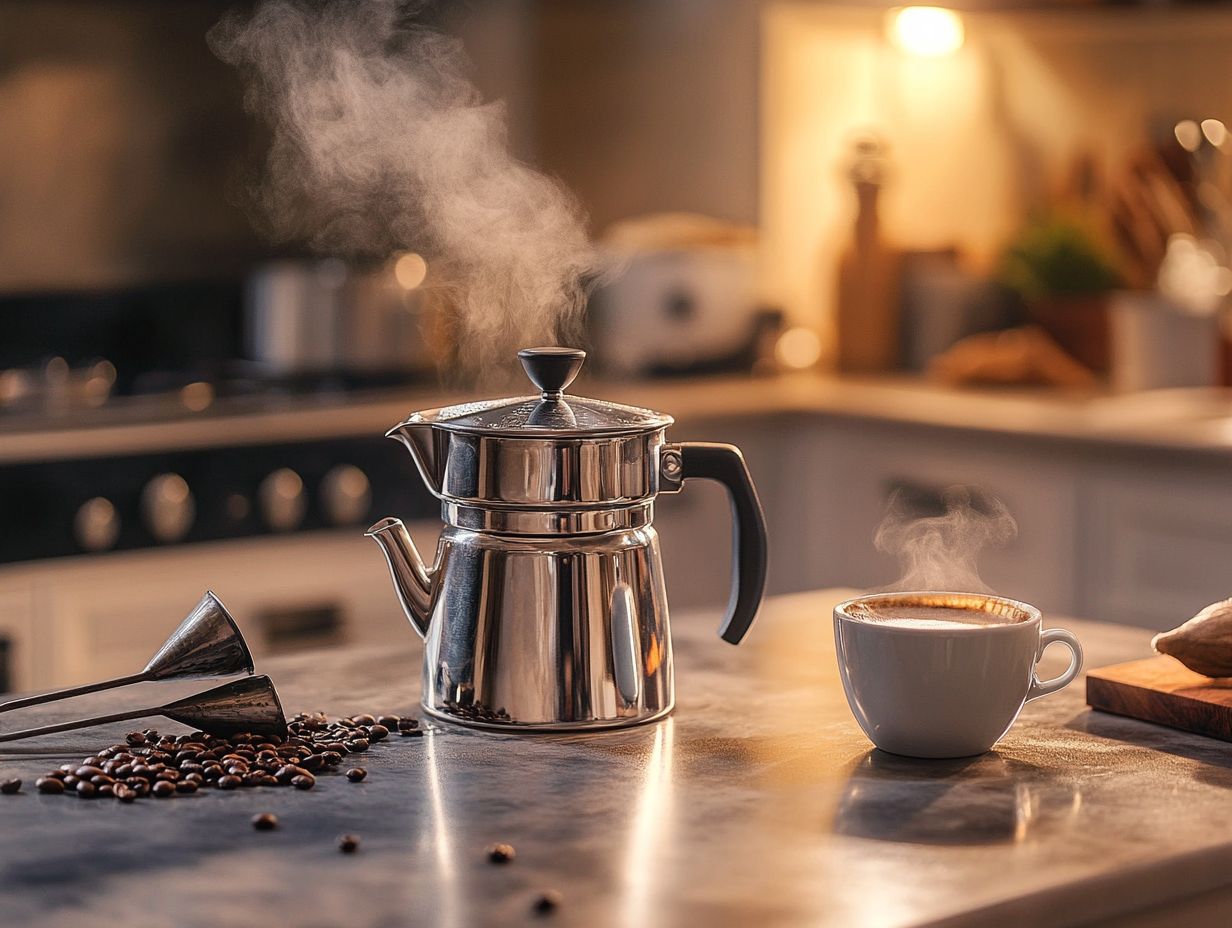
Regular cleaning and maintenance of your percolator are essential for preserving the quality of your coffee. A spotless percolator ensures that old coffee oils and residues do not compromise the taste or aroma of your next brew. By employing effective cleaning methods, you can elevate your coffee preparation experience and extend the lifespan of your percolator.
Neglecting this upkeep can result in unpleasant flavors that taint every cup you brew. To maintain your percolator, consider using natural cleaning agents like baking soda and vinegar; they are not only effective but also eco-friendly. A simple mixture of these two can effortlessly eliminate stubborn stains and build-up while deodorizing the interior.
It s wise to clean your percolator after each use and conduct a deep clean with these agents at least once a month. Start cleaning your percolator today to taste the difference in your next cup! By incorporating these straightforward practices, you can enjoy a consistently delicious brew, free from unwanted residues and flavors.
What Are the Pros and Cons of Using a Percolator?
Using a coffee percolator has unique advantages and disadvantages.
These factors can affect your preferences as a coffee enthusiast.
On the brighter side, percolators are celebrated for their ability to produce a strong cup of coffee, delivering a bold flavor profile. This is largely due to the brewing process, which effectively extracts rich oils from the coffee grounds.
Be cautious when brewing coffee; if you brew too long, you risk over-extraction, which leads to an unpleasantly bitter flavor. Monitor brewing carefully to avoid this issue.
Frequently Asked Questions
What is a coffee percolator and why is it used to brew coffee?
A coffee percolator is a type of coffee brewing device that uses gravity to circulate hot water through coffee grounds to extract bold flavor and produce a strong, flavorful cup of coffee. Many coffee enthusiasts love this brewing method for its rich aroma and strong flavor!
What type of coffee should I use when brewing with a percolator coffee pot?
You can use any type of coffee grounds when using a percolator, but a coarse grind is recommended for best results. This allows for better extraction and prevents the grounds from escaping into your cup. Using a medium roast or dark roast can enhance the flavor profile of your percolator coffee.
How do I prepare my percolator for brewing coffee?
Before brewing, make sure to clean your percolator thoroughly and remove any old coffee grounds.
Then, fill the percolator with cold water and add the desired amount of coffee grounds to the basket or chamber. Proper coffee preparation is key to achieving the best brewing experience.
What is the proper percolation time for a percolator?
The percolation time can vary depending on personal preference and the desired coffee strength.
A general rule of thumb is to let the coffee percolate for 7-10 minutes for a strong cup and 5-7 minutes for a milder cup. Adjust the water ratio based on your taste preferences.
Can I add other ingredients to my coffee while using the percolator brewing method?
Yes, you can add ingredients such as cinnamon, spices, or even sugar to your coffee grounds before brewing.
This will infuse additional flavors into your coffee and create a unique and delicious cup. Don t miss out on the chance to experiment with coffee recipes for delightful results!
How do I clean and maintain my coffee percolator for future use?
After each use, it is important to thoroughly clean and dry your percolator to prevent buildup and maintain its quality.
This includes removing and washing all parts, including the basket and stem, with warm soapy water. You can also periodically descale your percolator with a mixture of water and vinegar to remove any buildup. Following these percolator instructions will help ensure your coffee-making techniques remain effective.

